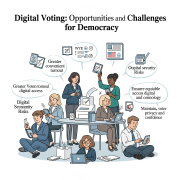Digital Voting: Opportunities and Challenges for Democracy
Digital Voting’s Prospect
Digital voting, also known as electronic voting, is a method of voting that utilizes digital tools and internet-based platforms. Proponents claim this approach may:
- Let people vote from the comfort of their own homes, particularly those with mobility issues or living overseas, thereby increasing voter participation.
- Streamline vote counting and reduce election administrative expenses.
- Adaptive interfaces and user-friendly design help those with disabilities increase access.
Difficulties with Election Integrity
 Digital voting raises significant concerns regarding security and transparency despite its benefits. Real problems are hacking, vote manipulation, and server breaches. Verifying the veracity of outcomes becomes challenging without a paper trail, and public confidence in the system could fade.
Digital voting raises significant concerns regarding security and transparency despite its benefits. Real problems are hacking, vote manipulation, and server breaches. Verifying the veracity of outcomes becomes challenging without a paper trail, and public confidence in the system could fade.
Experts also caution on the digital divide. Not all people have consistent internet access or the technical competence required to vote online, therefore aggravating voter disparity.
Learning from Global Experiments
Offering a glimpse of what digital democracy can look like, nations like Estonia have instituted national online voting systems with remarkably positive results. Other countries, including the United States and Canada, have handled internet voting carefully, preferring trial projects and limited use due to cybersecurity issues.
Juggling Originality with Prudence
Governments must find a balance in the future between supporting innovation and upholding democratic procedures. Investing in safe infrastructure, open auditing systems, and inclusive policies guaranteeing no voter is left behind is therefore essential.
Only if done properly will digital voting help to strengthen democracy. Subscribe to our newsletter or review our election technology section for further information and professional analysis to keep informed about the future of democracy and tech in politics.



